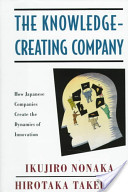The Nonaka and Takeuchi Knowledge Spiral Model
|
Two leading Japanese business experts, Ikujiro Nonaka and Hirotaka Takeuchi, were the first to tie the success of Japanese companies to their ability to create new knowledge and use it to produce successful products and technologies. The Nonaka and Takeuchi model of KM has its roots in a holistic model of knowledge creation and the management of 'serendipity'. The tacit/explicit spectrum of knowledge forms (the epistemological dimension) and the individual/group/organizational or three-tier model of knowledge sharing and diffusion (the ontological dimension) are both needed to create knowledge and produce innovation (Dalkir, 2011, p.64). The authors point out that there are two types of knowledge: explicit knowledge, contained in manuals and procedures, and tacit knowledge, learned only by experience, and communicated only indirectly, through metaphor and analogy. U.S. managers focus on explicit knowledge. The Japanese, on the other hand, focus on tacit knowledge. And this, the authors argue, is the key to their success - the Japanese have learned how to transform tacit into explicit knowledge. They argue that Western culture considers knower and known as separate entities. In contrast, the stuctural characteristics of the Japanese language and influences such as Zen Buddhism led the Japanese to consider that there is a oneness of humanity and nature, body and mind, and self and the other (Nonaka and takeuchi, 2005 as cited in Dalkir, 2011, p.65). |
|
| Ikujiro Nonaka |
|
In The Knowledge-Creating Company (1995), Nonaka & Takeuchi provide an inside look at how Japanese companies go about creating this new knowledge organizationally. To explain how this is done, the authors range from Greek philosophy to Zen Buddhism, from classical economists to modern management gurus, illustrating the theory of organizational knowledge creation with case studies drawn from such firms as Honda, Canon, Matsushita, NEC, Nissan, 3M, GE, and the U.S. Marines. For instance, using Matsushita's development of the Home Bakery, they show how tacit knowledge can be converted to explicit knowledge: when the designers couldn't perfect the dough kneading mechanism, a software programmer apprenticed herself with the master baker at Osaka International Hotel, gained a tacit understanding of kneading, and then conveyed this information to the engineers. In addition, the authors show that, to create knowledge, the best management style is neither top-down nor bottom-up, but rather what they call "middle-up-down," in which the middle managers form a bridge between the ideals of top management and the chaotic realities of the frontline. Nonaka and Takeuchi are arguing that creating knowledge will become the key to sustaining a competitive advantage in the future. Because the competitive environment and customer preferences changes constantly, knowledge perishes quickly. With The Knowledge-Creating Company, managers have at their fingertips years of insight from Japanese firms that reveal how to create knowledge continuously, and how to exploit it to make successful new products, services, and systems [http://books.google.ee/books?id=B-qxrPaU1-MC&printsec=frontcover#v=onepage&q&f=false]. |
 |
Licensed under the Creative Commons Attribution Non-commercial No Derivatives 3.0 License